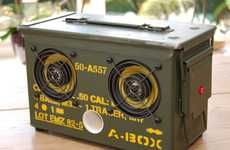
Power Dreaming is U.S. Army's Way to Rid Nightmares
Omar Yusuf — October 31, 2011 — Tech
The U.S. military has been forced to invest in treatments for post-traumatic stress disorder (PTSD) due to the overwhelming number of afflicted veterans returning stateside, and ‘Power Dreaming’ is their most recent and most novel method of confronting night terrors and anxiety.
The Bremerton Naval Hospital in Washington State has been the go-to clinic for discharged veterans of the conflicts in Iraq and Afghanistan, ostensibly a place where their haunting memories and the left-over trauma can finally be remedied. Power Dreaming is the flagship of the Bremerton institution and works by transmitting soothing, familiar images via a pair of specialized 3D glasses.
"The computer program for soldiers to build out imaginary worlds and avatars on will be based on the virtual world Second Life," Wired explains. "It will allow dream sequences to be custom designed 'to develop physio-emotional states to counteract the reactive stress response inherent in trauma memories.'"
The hope is that, after weeks of this therapy, the soldiers will begin to associate positive feelings with these images to counteract the nightmarish visions in their sleep.
Although the program is still in its early stages, officials expect it to become the mainstay technique for treating post-combat terrors.
The Bremerton Naval Hospital in Washington State has been the go-to clinic for discharged veterans of the conflicts in Iraq and Afghanistan, ostensibly a place where their haunting memories and the left-over trauma can finally be remedied. Power Dreaming is the flagship of the Bremerton institution and works by transmitting soothing, familiar images via a pair of specialized 3D glasses.
"The computer program for soldiers to build out imaginary worlds and avatars on will be based on the virtual world Second Life," Wired explains. "It will allow dream sequences to be custom designed 'to develop physio-emotional states to counteract the reactive stress response inherent in trauma memories.'"
The hope is that, after weeks of this therapy, the soldiers will begin to associate positive feelings with these images to counteract the nightmarish visions in their sleep.
Although the program is still in its early stages, officials expect it to become the mainstay technique for treating post-combat terrors.
Trend Themes
1. Virtual Reality Therapy - Using virtual reality technology to treat PTSD and anxiety by creating custom dream sequences to counteract trauma memories.
2. Emotional State Manipulation - Exploring techniques that develop physio-emotional states to counteract stress response in traumatic memories.
3. Personalized Mental Health Treatment - Developing individualized therapy methods using technology to address specific mental health conditions.
Industry Implications
1. Healthcare - Implementing virtual reality and personalized therapy in mental health treatments for veterans and individuals with PTSD.
2. Technology - Creating innovative virtual reality programs and tools for mental health therapy and emotional state manipulation.
3. Military - Adopting advanced techniques like Power Dreaming to treat post-combat terrors and support the mental health of military personnel.
0.8
Score
Popularity
Activity
Freshness























